Col. Sudhir Farm

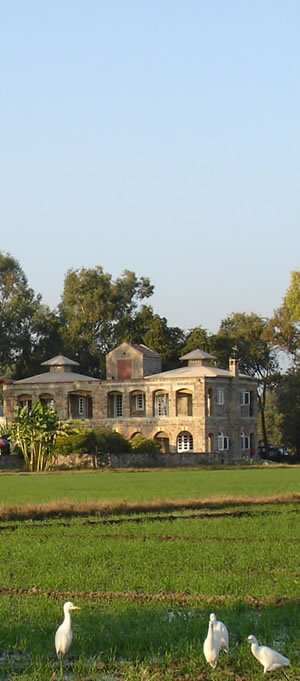
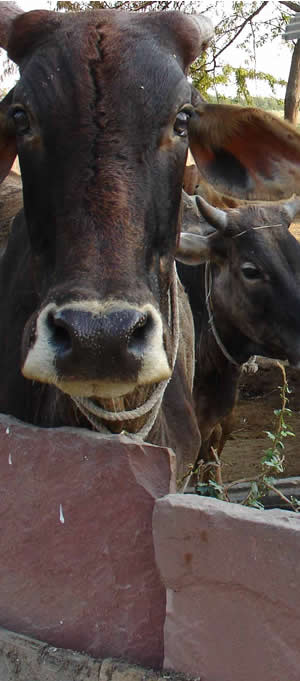
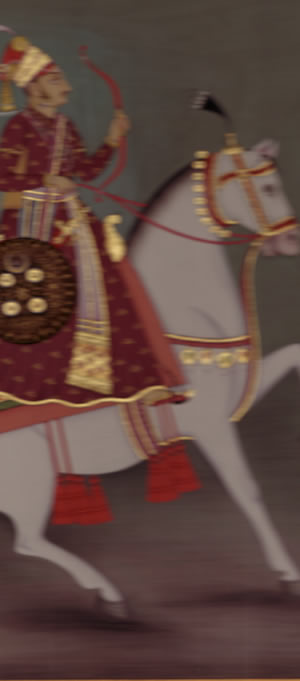
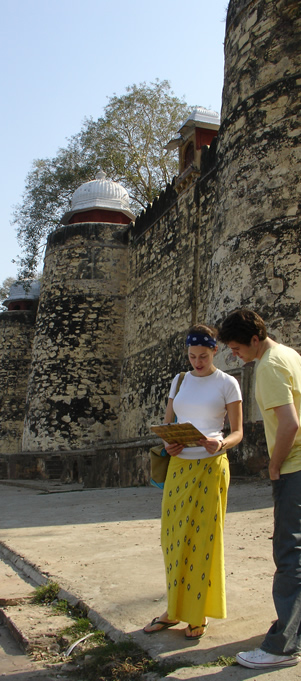
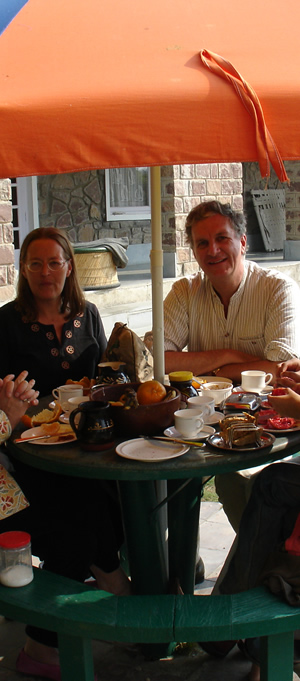
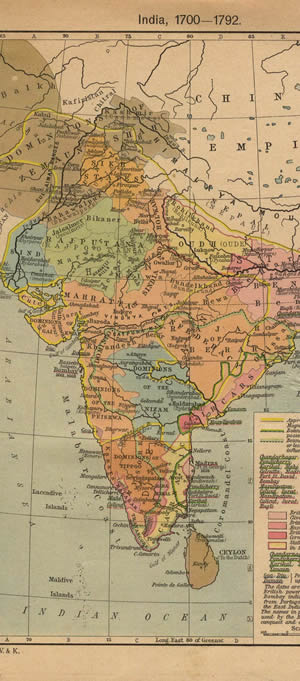
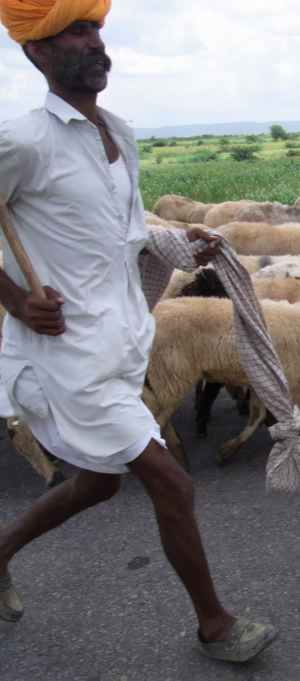
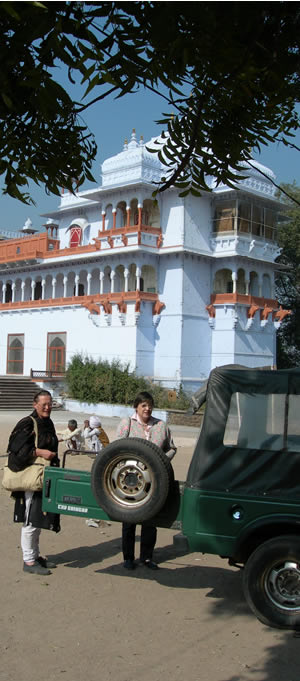
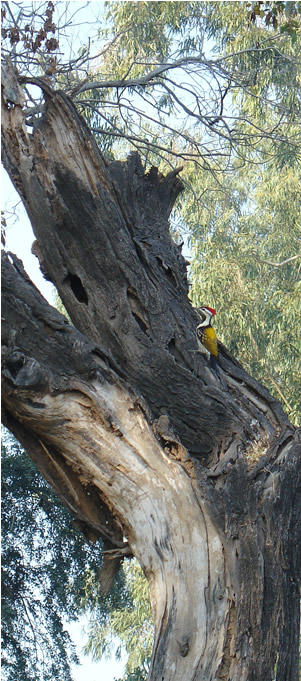
Snippets from the Visitors' Book
The Kota tonga trail was a real highlight - a bit like a 19th Century treasure hunt. It’s full of little nuggets of unusual information and fascinating glimpses into the unsolved mysteries of Kota.
Harriet and Will, London. UK
The memorial to Major Burton and his sons was much more moving than the Taj Mahal or the lake at Udaipur, marvellous as they are.
Henry Vane, Cumbria, UK
...the most comfortable bed I’ve slept in for 2 months....
Charlotte Adam, Winchester UK
Two days out of the noise and the people in a beautiful place. We felt totally
at home
- To be recommended to every person who wishes to experience the Indian country life. We also liked the way the food was prepared...
Patrick & Marie-Christine Lemaigre, Nil-St Vincent, Belgium
We’re only here for the porridge and home made bread! Thank you for a most wonderful time the memories of which we shall carry always. You have given us a wonderful & fascinating introduction to India.
Sue Turner, Lancashire, UK
So ...Rajasthan is not all desert! Thank you for sharing everything with us....
The Read family, London, UK
What a wonderful time we’ve had at the school in the village, at the weavers’, on the river, atop a tonga! Thank you for all your help and contacts throughout India
Anne Gerbner, Philadelphia, USA
It was a wonderful stay and thank you for giving us such a positive look at India and Rajasthan.
Salma Goldstein, New Jersey, USA
- There once was a lady of Kota
- Who took visitors out in her motor
- With the roads and the ruts
- It took quite some guts
- To go out with the lady of Kota.
- But once back at home on the farm
- The world quite descended to calm
- With the plants and the birds
- And fox terriers in herds
- There was balm in the calm on the farm.
Sue Millar, London, UK
After travelling around Rajasthan for two weeks, reaching a real house with books on the shelves, photos on the walls and four happy dogs was simply wonderful.
Camille Savinien, Paris, France
This isn’t tourism. I know of nowhere else where you can experience the real India as well as on your traditional working Rajasthani farm.
Sam Milward, Wellington, New Zealand
Thank you so very much for such a wonderful stay - what a fantastic introduction to India. I don’t think we’ll find such tranquillity elsewhere.
Lizzie Fortune, Hampshire. UK
Fabulous - I’ve been spoilt. It’s hard to leave and face the real world.
Elisabeth Simson, Isle of Wight, UK
After travelling around Rajasthan for two weeks, reaching a real house with books on the shelves, photos on the walls and four happy dogs was simply wonderful.
Camille Savinien, Paris, France
This isn’t tourism. I know of nowhere else where you can experience the real India as well as on your traditional working Rajasthani farm.
Sam Milward, Wellington, New Zealand
Thank you so very much for such a wonderful stay - what a fantastic introduction to India. I don’t think we’ll find such tranquillity elsewhere.
Lizzie Fortune, Hampshire. UK
Our visit at the farm was truly wonderful, off the beaten track it is a slice of India a visitor does not normally experience. Victoria is very knowledgeable about Indian culture and the people - an added perspective for us. The food here was very delicious: organically home grown ingredients, vegetables, fruits, grains prepared simply homestyle. A nice change from curries. Enjoyed the early morning boat ride and walk to the weavers. Many thanks.
Johanna Janssens, Washington, USA
I loved staying with you and the dogs and playing with the toys.
Jonas aged 8, Switzerland
A very welcome break from the crazy world of India – wonderful house, food and hospitality. Thank you so much.
Katie Buxton, Bath, UK
I loved seeing the crocodiles, and I learned a lot about deticking the puppies. Coming to the farm was a great experience.
Stella Bartholet, Washington, USA
A wonderful eye opening visit in every sense. We will be back! Thank you!
Christopher & Joanna Hobson, Northamptonshire, UK
A blissfully peaceful stay. We enjoyed everything – even the power cut. Thank you for lovely food, good company and very interesting trips.
Vicky Stark, London, UK
Exactly what we hoped for and more, bits of India off the tourist track, life as it actually is in villages, teeming life and livestock and the magic of the river.
Sir Hilary Miller, Worcester, UK
Thank you for the introduction to miniature painters, wall paintings, stories, great food, good company, walk through the fields. I loved the paintings in the City Palace and go back full of inspiration and memories.
Nan Mulder, Edinburgh, UK

On the Farm - 2015 Archive
On the Farm - December ’15
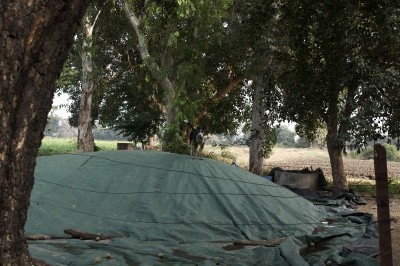 December started with one hour of rain and we have had none since.
December started with one hour of rain and we have had none since.
Lucy is standing guard over the rice waiting to be sold. The mustard behind her is just beginning to flower and the bare field was planted with coriander on 5th November and is yet to flush green.
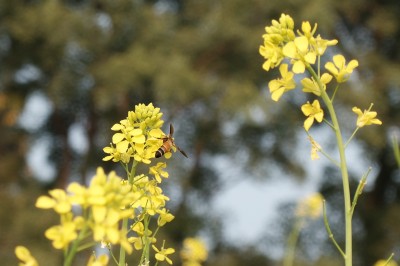 The flowering mustard was magnificient all month. Now that we are bee aware we were hoping to find rare bees in the mustard but there was only apis dorsata, Indian rock bee, which is India’s largest bee. The Indian honey bee, apis cerana was not to be seen.
The flowering mustard was magnificient all month. Now that we are bee aware we were hoping to find rare bees in the mustard but there was only apis dorsata, Indian rock bee, which is India’s largest bee. The Indian honey bee, apis cerana was not to be seen.
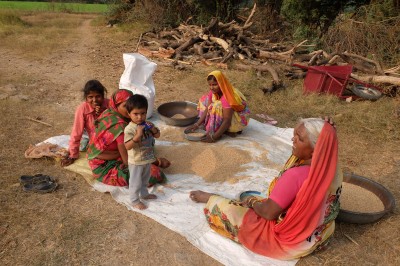 This month the wheat was planted. We planted some heritage wheat C306 for home consumption, and some of last year’s 4037 seed variety was also planted. Here the women are grading the wheat so the larger grains are planted.
This month the wheat was planted. We planted some heritage wheat C306 for home consumption, and some of last year’s 4037 seed variety was also planted. Here the women are grading the wheat so the larger grains are planted.
We also planted some wheat provided by ITC (India Tobacco Company) called HI-1544, which will be used by their milling division for superior flour. They pay above the market rate as long as the grain is not rain or hail damaged or mixed with soil. We have told them we won’t be spraying it but they are more interested in the yield than possible toxicity and wouldn’t mind if we did.
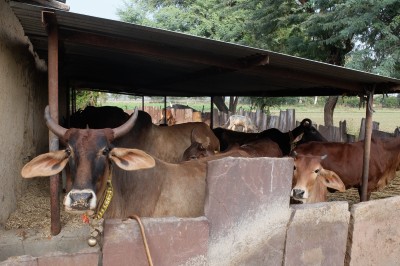 All these cattle and not a drop of milk in November or December. This is because they are male or female but too old, too young or pregnant. Indian economic reality is that four or five cows have to be fed and looked after for one to be in milk.
All these cattle and not a drop of milk in November or December. This is because they are male or female but too old, too young or pregnant. Indian economic reality is that four or five cows have to be fed and looked after for one to be in milk.
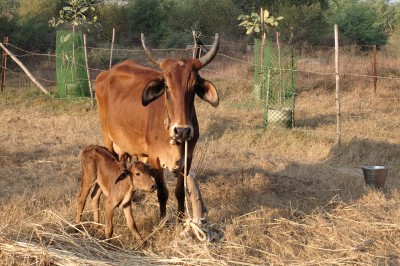 On the last day of December the first pregnant cow, Tikku, gave birth and here she is with her daughter, Saru.
On the last day of December the first pregnant cow, Tikku, gave birth and here she is with her daughter, Saru.
On the Farm - November ’15
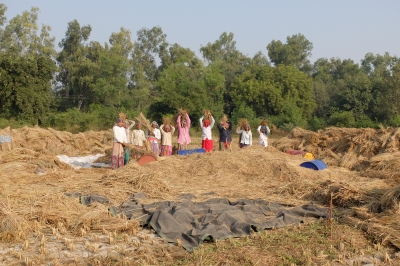 November was a very mild, dry month in which the rice was harvested, the fields cleared and watered and the next crop sown. The market price of rice before Diwali on 11th November was only Rs.1400 for 100 kgs. but within two weeks it had reached Rs.2000 and actually peaked at Rs.2400 the day before the market was closed for a two-day strike. We sold our unsprayed, hand-weeded rice at the end of the month for Rs.2121. The rest will be sold in December.
November was a very mild, dry month in which the rice was harvested, the fields cleared and watered and the next crop sown. The market price of rice before Diwali on 11th November was only Rs.1400 for 100 kgs. but within two weeks it had reached Rs.2000 and actually peaked at Rs.2400 the day before the market was closed for a two-day strike. We sold our unsprayed, hand-weeded rice at the end of the month for Rs.2121. The rest will be sold in December.
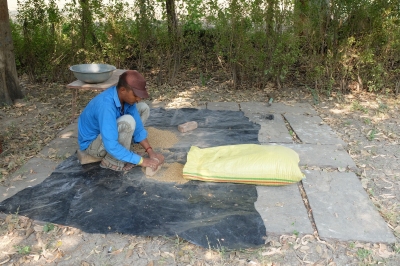 We decided to sow some coriander this year. Vinod is crushing the seeds to split them into two. This makes the seed go twice as far.
We decided to sow some coriander this year. Vinod is crushing the seeds to split them into two. This makes the seed go twice as far.
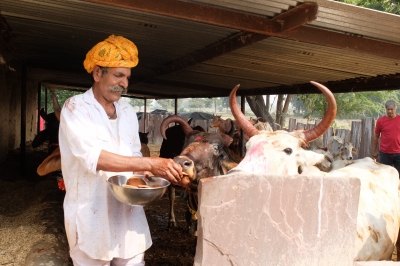 Diwali fell in November this year and is a major festival with the associated Govardhan puja for honouring the cows. This may be Mun-mun’s last Diwali as she is 22 but she always enjoys her sweetened puris. You can see that the cows’ horns have been coloured with mehendi (henna) and linseed oil. This is good for the horns as well as being decorative.
Diwali fell in November this year and is a major festival with the associated Govardhan puja for honouring the cows. This may be Mun-mun’s last Diwali as she is 22 but she always enjoys her sweetened puris. You can see that the cows’ horns have been coloured with mehendi (henna) and linseed oil. This is good for the horns as well as being decorative.
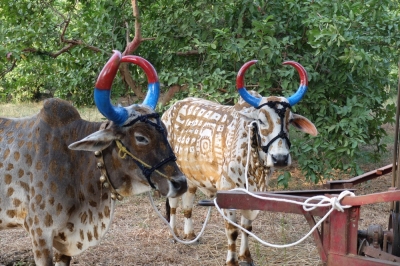 These handsome bullocks belong to our brother-in-law and are decorated traditionally with mehendi. They are the last pair of bullocks left in their village as tractors have replaced them. Although their horns look very striking, it can’t be good for them to be fashionably painted in enamel paint.
These handsome bullocks belong to our brother-in-law and are decorated traditionally with mehendi. They are the last pair of bullocks left in their village as tractors have replaced them. Although their horns look very striking, it can’t be good for them to be fashionably painted in enamel paint.
On the Farm - October ’15
October is a harvesting month. We had to decide which soyabean fields to harvest and which to plough in. We wanted the chaff as fodder for the cows and so went ahead and paid a team of women to hand cut the crop. The farmer on the other side of the boundary hedge cut his losses and ploughed all his soyabean crop in.
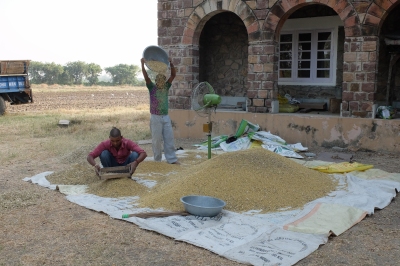
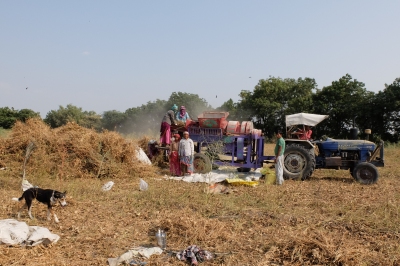
The women started cutting on 14th and threshed on 20th. Our men moved the piles of bhoussa over to the cowshed and then winnowed the soyabeans to remove the remaining husk and stalks. 24 bags were reduced to 20. That weighed 784 kgs. and at Rs. 35.51, after labour costs, it netted only Rs. 27,780. The input costs of the crop were closer to Rs. 100,000. Very expensive fodder. We hope that the nitrogen fixed in the soil by the soyabean will boost the yield of the following crop: wheat or coriander. We have had no rain since mid-August and it seems to have been too hot for the soyabean.
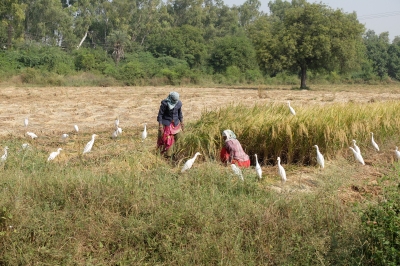 The rice by contrast is a very good crop where it has been grown in a field for the first time. This is ironic as rice uses large amounts of scarce ground water and is not appropriate for Rajasthan as a whole. We kept watering it from the borewell until allowing it to dry out. Here the women are cutting the last strands in our 10 bigha field which has not been sprayed at all, and hand weeded just once. The cattle egrets are appreciating this chance to catch organic food and have little to fear from the women. There was less pig damage than last year. Someone appears to have been dealing with the pigs and it hasn’t been us.
The rice by contrast is a very good crop where it has been grown in a field for the first time. This is ironic as rice uses large amounts of scarce ground water and is not appropriate for Rajasthan as a whole. We kept watering it from the borewell until allowing it to dry out. Here the women are cutting the last strands in our 10 bigha field which has not been sprayed at all, and hand weeded just once. The cattle egrets are appreciating this chance to catch organic food and have little to fear from the women. There was less pig damage than last year. Someone appears to have been dealing with the pigs and it hasn’t been us.
On the Farm - September ’15
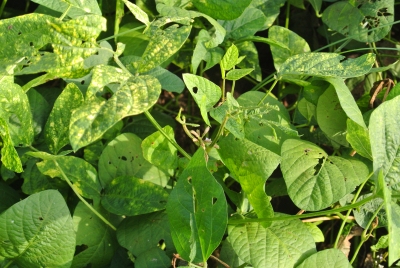 No rain, high humidity, and high temperatures, and excessive exposure to solar radiation in September seem to have been the main reasons for a catastrophic soyabean season across North India. The pods didn’t set and amongst the ones that did develop there were many that were flat. On our farm there were more pods nearer to the boundary hedge which suggest that it had some sort of sheltering role. There was a certain amount of insect attack which we ignored but people who sprayed did no better.
No rain, high humidity, and high temperatures, and excessive exposure to solar radiation in September seem to have been the main reasons for a catastrophic soyabean season across North India. The pods didn’t set and amongst the ones that did develop there were many that were flat. On our farm there were more pods nearer to the boundary hedge which suggest that it had some sort of sheltering role. There was a certain amount of insect attack which we ignored but people who sprayed did no better.
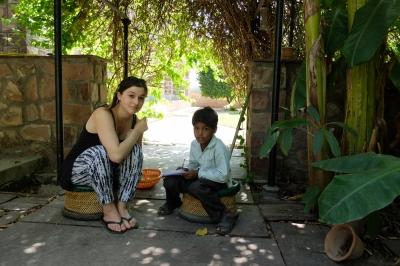 Our daughter, Anjali, came to stay so Dashrath was able to benefit from some more interesting individual coaching sessions. His parents had signed him up for coaching classes after school in the village. This meant he left home at 7.00 am and returned at 4.30 pm, having been sitting still all day with a half-an-hour lunch break. He is about eight. We got his bicycle fixed so that at least he could take exercise and have some fun whizzing about when he got home.
Our daughter, Anjali, came to stay so Dashrath was able to benefit from some more interesting individual coaching sessions. His parents had signed him up for coaching classes after school in the village. This meant he left home at 7.00 am and returned at 4.30 pm, having been sitting still all day with a half-an-hour lunch break. He is about eight. We got his bicycle fixed so that at least he could take exercise and have some fun whizzing about when he got home.
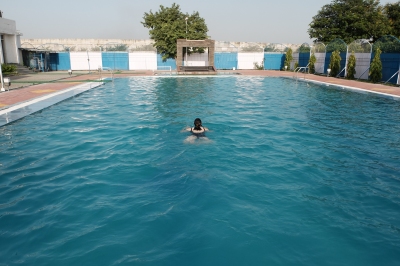 For our exercise we are lucky enough to be able to go to the nearby Kota Club pool at 7.00 am when no one else is there. For us swimming is the only exercise enjoyable in high humidity.
For our exercise we are lucky enough to be able to go to the nearby Kota Club pool at 7.00 am when no one else is there. For us swimming is the only exercise enjoyable in high humidity.
On the Farm - August ’15
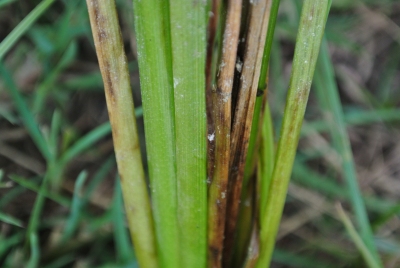 The monsoon had got off to a good start but petered out by mid-August. We started to water the soyabean by the end of the month from the borewells. Our plants were tall and healthy but the pods didn’t seem to set.
The monsoon had got off to a good start but petered out by mid-August. We started to water the soyabean by the end of the month from the borewells. Our plants were tall and healthy but the pods didn’t seem to set.
Our 10 bighas of rice was hand weeded by a band of 25 women. The rest of the rice, which was under a crop sharing arrangement, was sprayed with herbicide and by the end of August this rice was affected by blast and we were persuaded to allow it to be sprayed with insecticide. There were noticeably fewer butterflies around this monsoon and this didn’t help.
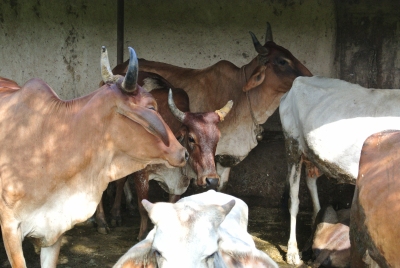 The cows enjoyed the fresh grass but poor Meera was attacked by another cow and the outer casing of her left horn came off revealing a bleeding mass. Here she can be seen with her bandaged stump noticeably shorter that the other horn.
The cows enjoyed the fresh grass but poor Meera was attacked by another cow and the outer casing of her left horn came off revealing a bleeding mass. Here she can be seen with her bandaged stump noticeably shorter that the other horn.
During a spectacular lightning storm on 9th August, which I was watching from the upstairs balcony, a huge glowing fireball was seen to descend instantly on one side of a nearby eucalyptus tree from its top to the ground; this was accompanied with a deafening clap of thunder. A few smaller outlying branches got singed and amazingly there was little damage to the tree otherwise. We have never seen anything like that before! The tree was just about 40 meters from where I was. The same phenomenon was also witnessed from the kitchen downstairs and our observations were corroborated.
On the Farm - July ’15
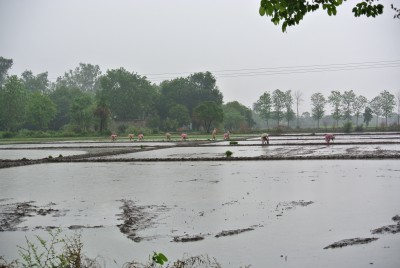 By 10th July all the rice had been transplanted by a team of Biharis. The pumps run day and night to keep the fields flooded. One transformer needed changing last month as it was sparking and causing fires. That one had been transported in a small pick-up truck.
By 10th July all the rice had been transplanted by a team of Biharis. The pumps run day and night to keep the fields flooded. One transformer needed changing last month as it was sparking and causing fires. That one had been transported in a small pick-up truck.
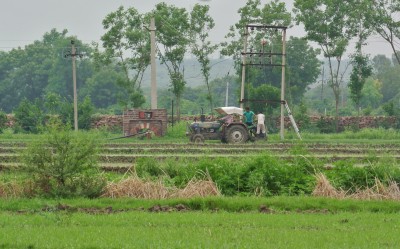 On 21st July the transformer at the far end of the farm had to be changed also and the only vehicle able to reach it through the mud was the tractor. It took three days work to lower, transport, replace, transport back and re-install.
On 21st July the transformer at the far end of the farm had to be changed also and the only vehicle able to reach it through the mud was the tractor. It took three days work to lower, transport, replace, transport back and re-install.
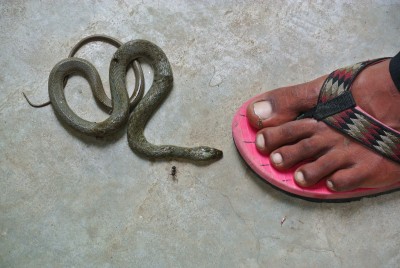 Meanwhile, we have had very heavy rain and there is always a risk of snakes. We give the men ‘gumboots’ as they are called here but sometimes they prefer chappals. On the 17th of July this small snake bit Vinod, but luckily it was non-venemous and there were several teeth marks rather than two deep puncture fang wounds. He survived, but the snake did not.
Meanwhile, we have had very heavy rain and there is always a risk of snakes. We give the men ‘gumboots’ as they are called here but sometimes they prefer chappals. On the 17th of July this small snake bit Vinod, but luckily it was non-venemous and there were several teeth marks rather than two deep puncture fang wounds. He survived, but the snake did not.
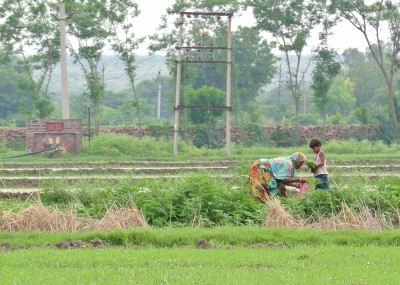 The vegetable patch has been ploughed with the tractor and some vegetables have been planted but they will be engulfed by meadow grass without constant weeding.
The vegetable patch has been ploughed with the tractor and some vegetables have been planted but they will be engulfed by meadow grass without constant weeding.
At this time of year there are several green food plants growing wild, such as, bhokna which we make into pakoras, khunijado, poadia and surli which are cooked like spinach. Here is Avanta Bai picking small green poadia leaves with the ever helpful Dashrath. It could almost be Kerala.
On the Farm - June ’15
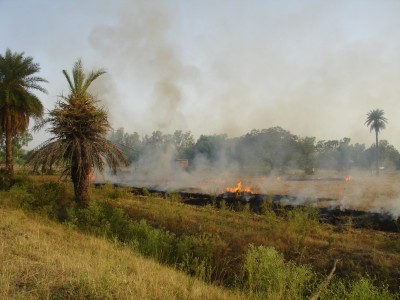 We started off the month by burning the wheat stubble. Here you can see a date palm tree which has been harvested by the broom makers and two that haven’t. New fronds will soon regrow (see May 2015).
We started off the month by burning the wheat stubble. Here you can see a date palm tree which has been harvested by the broom makers and two that haven’t. New fronds will soon regrow (see May 2015).
Punkey appeared with a mate on 9th June and we feared that a troop would take up residence but he visited twice more by himself and hasn’t been seen since.
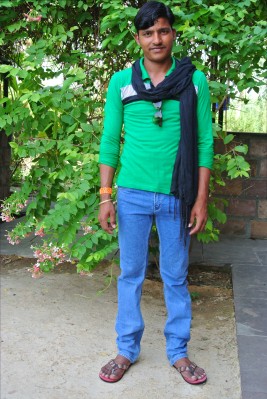 Vinod had an eventful June. He thinks he’s about 22. We took his photo at his request as he was going to get married. He left on 17th June for Maharashtra with only his father and a brother. The news arrived a few days later that the intended girl had refused him, but on the way back his father had found a girl from their community who was willing to marry him and they were engaged. The wedding will be after the summer when ‘the Gods have woken up.’ He does not know her name. He is making an effort to improve himself, however, and has learned the Hindi letters. He can recognise numbers. Little Dashrath (7) is teaching him to read and I’m providing workbooks and a slate. He has bought an old motorbike that has no papers. We can’t prevent him riding around untaxed, uninsured, unable to read any signs and without a helmet or eye protection.
Vinod had an eventful June. He thinks he’s about 22. We took his photo at his request as he was going to get married. He left on 17th June for Maharashtra with only his father and a brother. The news arrived a few days later that the intended girl had refused him, but on the way back his father had found a girl from their community who was willing to marry him and they were engaged. The wedding will be after the summer when ‘the Gods have woken up.’ He does not know her name. He is making an effort to improve himself, however, and has learned the Hindi letters. He can recognise numbers. Little Dashrath (7) is teaching him to read and I’m providing workbooks and a slate. He has bought an old motorbike that has no papers. We can’t prevent him riding around untaxed, uninsured, unable to read any signs and without a helmet or eye protection.
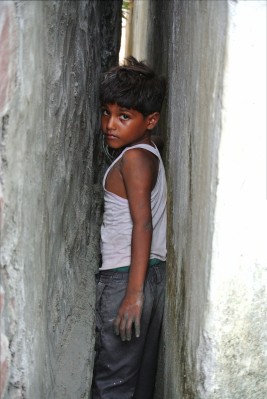
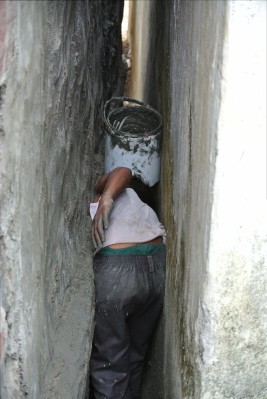 One of the jobs that needed doing in June was to replaster the garage and prevent rain water seeping through the house wall. The gap being too small for any of us, our resident child labour was able to squeeze in and do the work and was happy to be paid for his efforts.
One of the jobs that needed doing in June was to replaster the garage and prevent rain water seeping through the house wall. The gap being too small for any of us, our resident child labour was able to squeeze in and do the work and was happy to be paid for his efforts.
By the end of June we had had enough rain to sow soyabean and so the fields were prepared and the seed sown quickly before heavy rain prevented the tractor from getting on the land.
On the Farm - May ’15
A hot hot month with daily temperatures over 40oC each day. Some jobs are best undertaken at night like loading trollies with bhoussa or chaff to be taken to the cowshed for storage. Ploughing is sometimes done on moonlit nights.
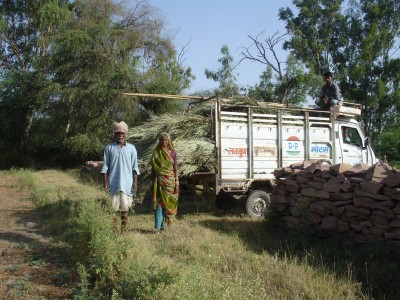
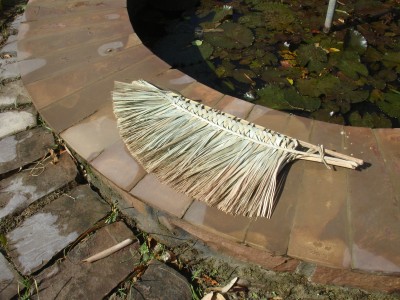
This couple, Ramesh and Shanti Bai, from the Bagri community, make date palm brooms. They cut fronds for three days and slept out in the open on the farm. They then called this van to transport their fronds back to their home for drying and manufacturing. They left 24 of these jharoos as goodwill "payment" which we shared out amongst our employees. Ramesh sells each one to a trader for Rs. 3 or 3 pence GBP, and they retail for Rs. 10 or 10 pence.
By May 19th, the temperature had built up to 46oC, our hottest day. The same evening the whole of Rajasthan was swept by the strongest dust/sand storm seen for years. It raged for two hours and left us without electricity until mid-day the next day.
After the storm we found that more than 10 cattle egret chicks had been blown out of their nests in the raini tree in the garden. Lucy, our dog, finished them off. The cattle egrets are not welcome residents as they make an extraordinary amount of mess. They also seem to be rather careless parents as one or two dead chicks are found each morning.
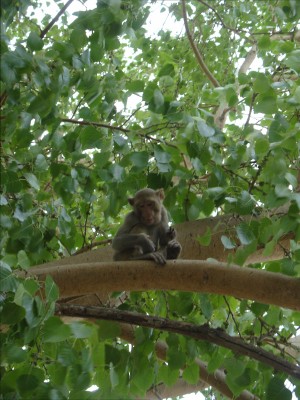 A more welcome resident is Punkey as in monkey-punkey. He’s a young one-armed rhesus macaque male (locally, red-faced monkey), with two bare bones for a left forearm and a ragged right ear. One can only guess how he came to be like that. He arrived on 23rd May and adopted us. Bananas, raw mangoes,roties/chapatis and roasted chick peas are all his favourites. He can circle the garden at roof level leaving our three dogs open-mouthed and staring under each perch silently waiting for him to drop; wisely Punkey is very wary of them. The dogs sleep inside in the cool all day leaving Punkey free to roam.
A more welcome resident is Punkey as in monkey-punkey. He’s a young one-armed rhesus macaque male (locally, red-faced monkey), with two bare bones for a left forearm and a ragged right ear. One can only guess how he came to be like that. He arrived on 23rd May and adopted us. Bananas, raw mangoes,roties/chapatis and roasted chick peas are all his favourites. He can circle the garden at roof level leaving our three dogs open-mouthed and staring under each perch silently waiting for him to drop; wisely Punkey is very wary of them. The dogs sleep inside in the cool all day leaving Punkey free to roam.
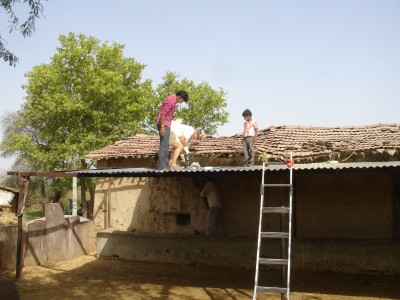 This month we also changed the corrugated metal sheets at the cowshed ready for the monsoon. Here is Vijay drilling holes at 0900 hrs. in 40oC.
This month we also changed the corrugated metal sheets at the cowshed ready for the monsoon. Here is Vijay drilling holes at 0900 hrs. in 40oC.
On the Farm - April ’15
In April the Government came under extreme pressure to compensate farmers for the heavy crop damage in March and in areas assessed to be worst the land owners received small cheques. These were not necessarily the people who had lost money. Many land owners take substantial rent per bigha in advance. The person paying that amount borrows it risking all on a good crop. They also borrow for seed and fertiliser. The result this year has been high debt levels among these small farmers and a crop of farmer suicides.
Our wheat crop was not damaged by the March hail stones, but several heavy showers in early April led to more broken and dis-coloured grains than usual and soil that stuck to the stalks mixed with the grain during threshing. Yields were poor and the price of Rs. 1281 per quintal (100 kgs.) for our hand cut wheat was the lowest for several years. Combine harvested wheat which sold for Rs. 1501 last year went for Rs. 1335 this year.
Here are the five women who worked hard to hand cut, tie the bundles, pile up and thresh our wheat so we could have chaff for the cows to eat. Enough wheat is left strewn in the fields to make it worthwhile for Sita and her children to glean; it is never too young in India to be economically active....
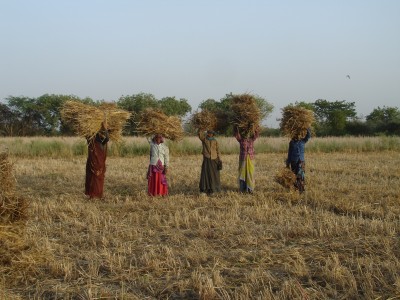
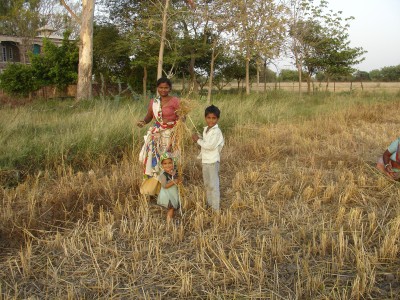
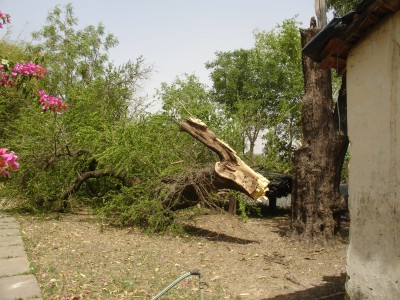 April saw the collapse of this main branch of our iconic kainth or wood apple tree. This tree was standing well before the house was built and before the land was cleared for farming. It has been hollow for years. Goodness knows how many generations of spotted owlets have been reared in its hollow. They have moved up into the last remaining main branch which is also hollow at its root - which doesn’t bode well for the long term. We miss the shade and reassuring presence.
April saw the collapse of this main branch of our iconic kainth or wood apple tree. This tree was standing well before the house was built and before the land was cleared for farming. It has been hollow for years. Goodness knows how many generations of spotted owlets have been reared in its hollow. They have moved up into the last remaining main branch which is also hollow at its root - which doesn’t bode well for the long term. We miss the shade and reassuring presence.
On the Farm - March ’15
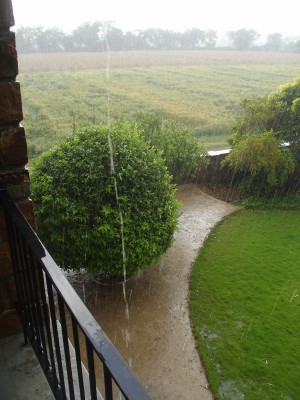 Most of North India will remember March 2015 as the year that the crops failed due to unseasonal heavy rains, hail and storms. We had ‘unseasonal’ heavy rain in January and again in February but March is a harvest month. Many ripe crops of coriander, mustard and wheat were totally flattened and destroyed by hailstones as big as golf balls on 12th March.
Most of North India will remember March 2015 as the year that the crops failed due to unseasonal heavy rains, hail and storms. We had ‘unseasonal’ heavy rain in January and again in February but March is a harvest month. Many ripe crops of coriander, mustard and wheat were totally flattened and destroyed by hailstones as big as golf balls on 12th March.
Our mustard had been cut and was lying drying in the fields when the rain came. It couldn’t be piled up and threshed until 21st March as it was so wet. The yield was 50% of former years in the same field. The crop had had a shorter growing period anyway because of high temperatures in the autumn so each seed was smaller and many pods were split by the hail.
Here battered looking green wheat can be seen with the cut mustard behind in a monsoon like downpour.
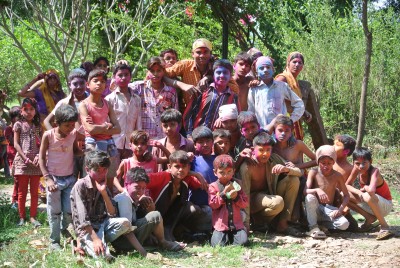 Holi was on 6th March this year before the rain and here is a photo of the largest group of village boys who walked here from the village in return for our good wishes and a chocolate biscuit.
Holi was on 6th March this year before the rain and here is a photo of the largest group of village boys who walked here from the village in return for our good wishes and a chocolate biscuit.
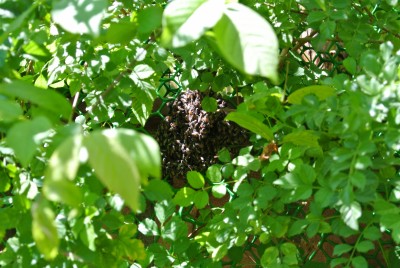 From little boys to little bees. We found this small comb of Apis florea bees in a shrub near the kitchen door. They are one of the four main species of honey bee found in India but are commercially more important for their pollinating work than their honey making.
From little boys to little bees. We found this small comb of Apis florea bees in a shrub near the kitchen door. They are one of the four main species of honey bee found in India but are commercially more important for their pollinating work than their honey making.
And from Apis florea to Endrilis eugeniae or African Nightcrawlers (worms) extensively bred in the west for fish bait. We were supplied with 5 kgs. of these worms as part of a new vermi-compost kit. It arrived like this and had to be assembled. The bottom layer of neem leaves was covered with cow manure or gobar. The worms were introduced and the whole bed soaked with water. Any resultant infused liquid which settles is collected from an outlet at the bottom and can be mixed with water in a 1:4 proportion prior to spraying on our organic vegetables as a fertiliser and mild insecticide; let’s see.
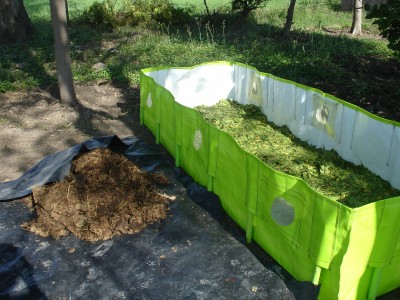
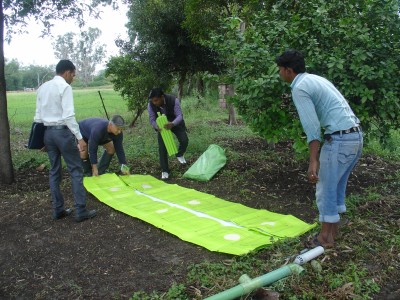
On the Farm - February ’15
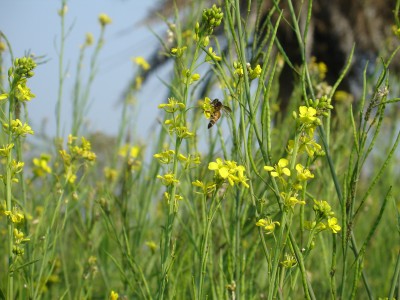 At the beginning of February the mustard was still flowering and here is our local wild bee that pollinates it. It makes a small nest in the undergrowth.
At the beginning of February the mustard was still flowering and here is our local wild bee that pollinates it. It makes a small nest in the undergrowth.
By 13th February the temperature had shot up leading to an explosion of aphids. Some plants at the edges of the fields seem to die from being sucked dry but we don’t spray. There is usually a rain storm that washes them away.
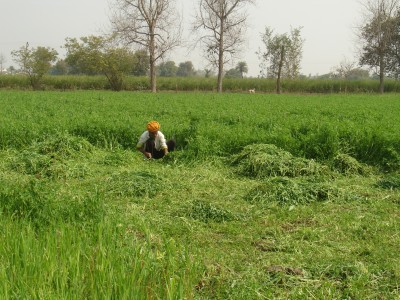 The cows don’t go out and have to be stall fed. It is a very arduous job every day for Mewalal cutting the berseem and carrying it to the cows.
The cows don’t go out and have to be stall fed. It is a very arduous job every day for Mewalal cutting the berseem and carrying it to the cows.
One of the calves developed a maggot wound between the two parts of her left hind hoof. We had to remove the maggots with tweezers and pack the cavity with guaze soaked in turpentine. A strong smelling black ointment was then smeared on top to keep the flies away. After a week of this treatment twice a day the wound dried up.
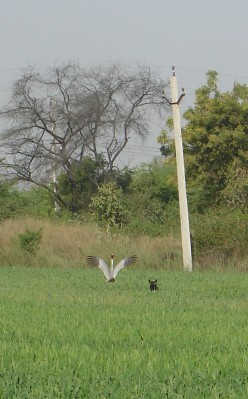 Bird watching is not always easy with three lively dogs. Here is Lucy chasing the sarus crane I was trying to photograph. There were three on the farm that morning and she chased them all away.
Bird watching is not always easy with three lively dogs. Here is Lucy chasing the sarus crane I was trying to photograph. There were three on the farm that morning and she chased them all away.
On the Farm - January ’15
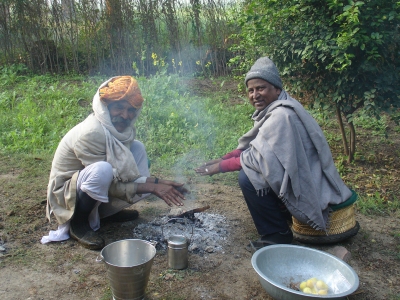 January is our mistiest month and on some days the sun barely came through and the year started with rain. The foggy weather causes a lot of illness and the main challenge for most people is keeping warm. For villagers this means huddling around open fires. Here Mewalal is warming himself alongside Kan Singh, driver of guests, having delivered the milk in the early morning.
January is our mistiest month and on some days the sun barely came through and the year started with rain. The foggy weather causes a lot of illness and the main challenge for most people is keeping warm. For villagers this means huddling around open fires. Here Mewalal is warming himself alongside Kan Singh, driver of guests, having delivered the milk in the early morning.
There was rain again on 22nd January so the fields did not need watering and the main activity was thinning and cutting back the boundary hedges. A hive of wild bees was found. We are becoming very conscious of our pollinators and our need to look after them. There is a lot less mustard around us this winter for the bees to feed on. A greater demand for urea for wheat led to shortages. We had to send a trolley 50 kms. to get some.
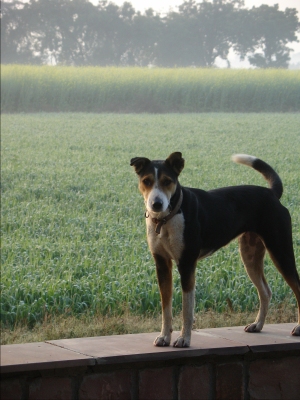 Here is Lucy on a misty morning with the tall mustard in the distance behind her and the young wheat in the foreground.
Here is Lucy on a misty morning with the tall mustard in the distance behind her and the young wheat in the foreground.

